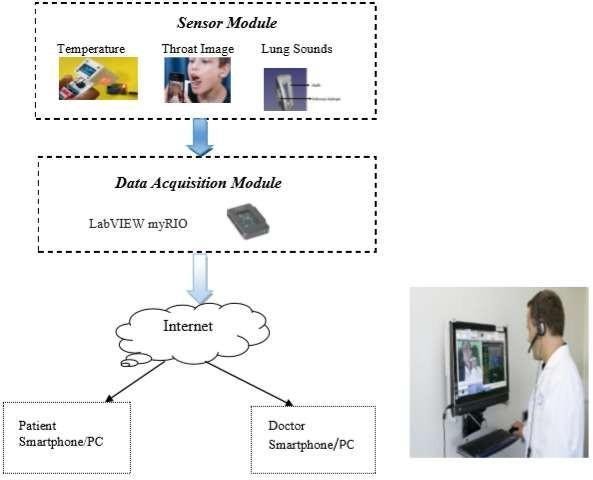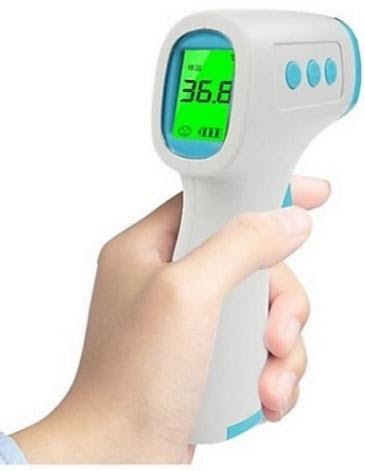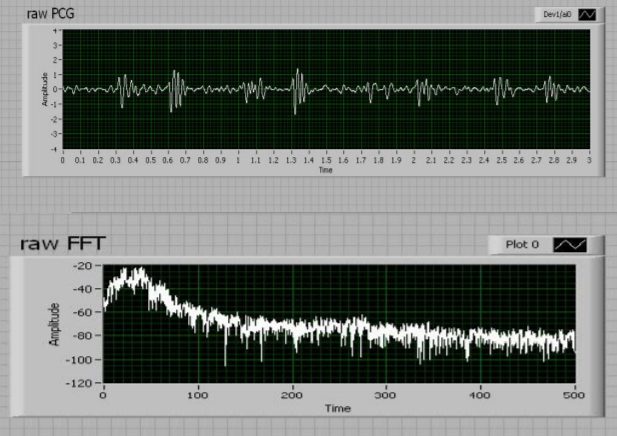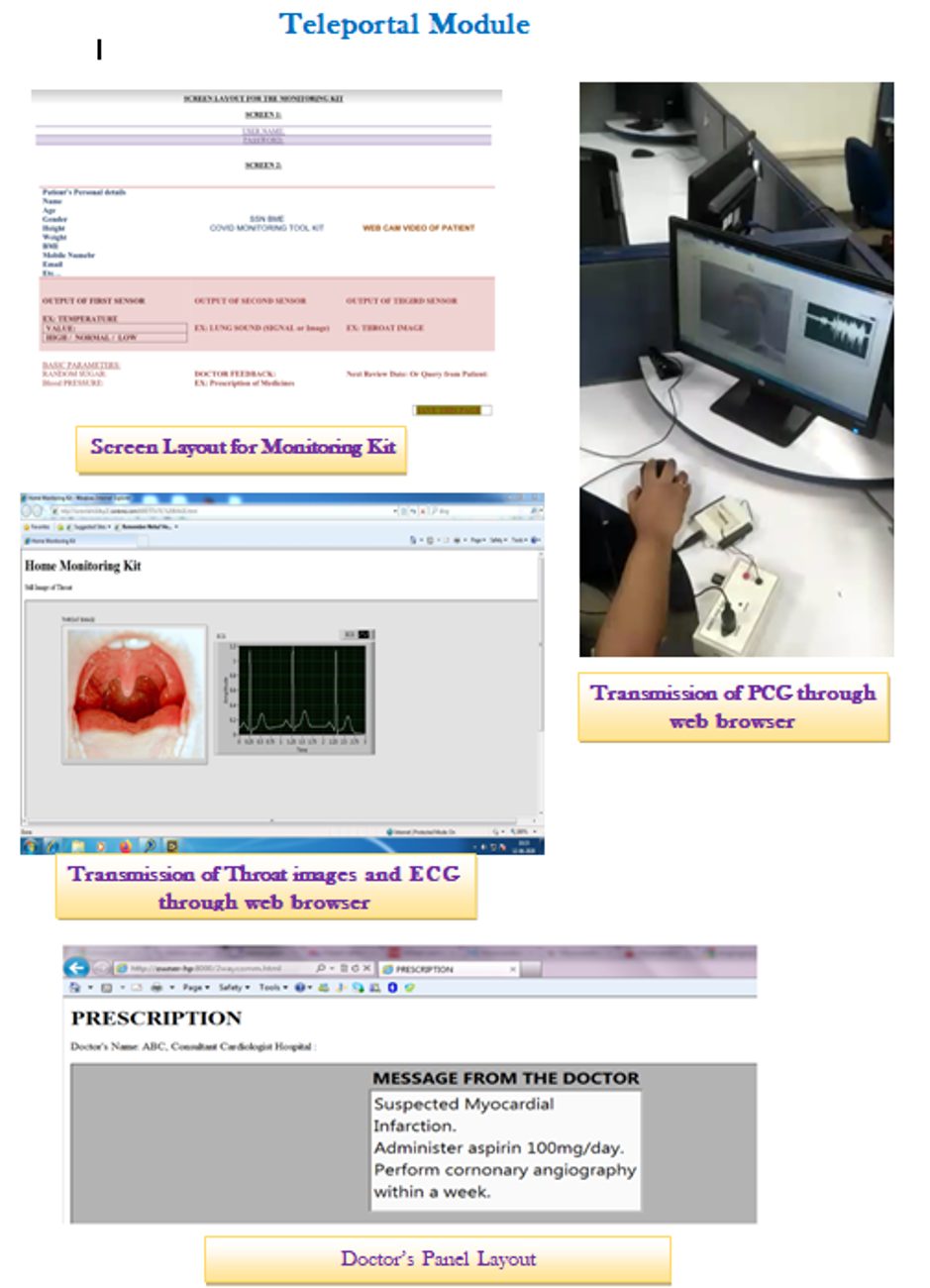COVID Home Care
As a response to COVID-19 challenge, the department of biomedical engineering (BME) at SSN has implemented home hospitalization kit as a team project. This project involved all the faculty members of the BME department. The aim of this proposed work is to monitor the health condition of the home hospitalized patients along with teleconsultation.
The kit consists of two main modules:
1) Data acquisition module
2) Tele-health module
It captures four main parameters related to COVID-19:
1) Temperature
2) Heart sound
3) Lung sound
4) Images of the oral cavity
The captured parameters were transmitted through internet protocol remotely from patient side to doctor side for consultation and prescription.
| Head | Dr. A. Kavitha, HOD, BME |
| Overall Coordinators | Dr. S. Pravin Kumar Ms. B. Divya |
| Student Team Overall Coordinator | Sandhanakrishnan R. |
| Module | Parameters to be Implemented | Faculty | Team Coordinator | Student Members |
| Data Acquisition Module | Non-invasive temperature detection system | Dr. S. Bagyaraj, Dr. S. Arun Karthick, Ms. B. Divya, Dr. R. Subashini | Dr. S. Bagyaraj | Srinithi R., Sivabaala M. |
| Digital heart and lung sound detection system | Dr. J. Vijay, Dr. A. Kavitha | Dr. S. Pravin Kumar | Sandhanakrishnan R., Kesavaraj V., Praveen Kumar. S |
|
| Oral Examination of Throat | Dr. K. Nirmala, Dr. L. Suganthi | Ms. R. Nithya, Ms. Dhanalakshmi | Gurucharan M. K. Rajkumar A. J. |
|
| Tele-health Consultation Module | Interfaced with data acquisition and transmission | Dr. B. Geethanjali, Dr. V. Mahesh | Dr. Sachin G. | Aghil Kavya, M. Bhuvaneshwari |
This work was intended to offer some technological solution to some of the challenged imposed by COVID-19 pandemic situation on healthcare ecosystem. Specifically, we try to address how a healthcare organization can provide hospital level care to acutely ill COVID-19 and other patients in their home.


The healthcare sector throughout the world faces a critical situation facing unprecedented demand for the hospital beds. Therefore, we intend to provide technological solutions to home quarantined patients with mild symptoms and thereby to ease up some of the burden on the hospitals at least partially. Through the proposed multilayer patient management system, there should be a change in the strategy, thereby allowing the mild or no-symptom patients to recover at home. At the same time, the vitals of the patient should not be compromised. All the COVID-19 vitals should be properly monitored and in turn should lead to a well-informed diagnostic decision. Also, when required the treatment plans should be remotely offered by the experts at the right time.
An application is proposed to monitor the health condition of the home hospitalized patients along with teleconsultation.
- To provide treatment solutions at home to COVID-19 patients with mild symptoms.
- To help reduce overcrowding at hospitals.
- To reduce the risk of COVID-19 transmission, especially for vulnerable patients as well as the doctors.
Proposed Work
| Description | |
|---|---|
| PHASE I: | Concept proof (COMPLETED) Using lab components and locally available resources |
| PHASE II: | Product level (ONGOING) Medical grade hardware (Vital Biosystems and GreenOcean Research labs) integrations |
| PHASE III: | Units deployment Societal contribution |
This work is planned to:
- To provide a telemetry solution for the healthcare provider to examine the patient’s lungs, heart, throat, and body temperature.
- To tele-consult the COVID-19 home quarantined and other critically ill patients.
The proposed application will have two panels on device screen. One panel is for video conferencing to the doctor to interact with him/her and the other panel provides instruction such as sensor placement. Once the sensors in place, the same panel can display the measured parameters. Thus, the parameters measured in the console by the patients are transmitted through the internet protocol and can be viewed in the doctor’s computer to make diagnostic decisions and to prescribe appropriate treatment plans.
COVID Home Care – Phase I
COMPLETED WORK IN PHASE I
- Developed Lab VIEW based data acquisition module (DAQ)
- Developed LabVIEW based telemetry and tele- consultation module
- Integrated DAQ and teleportal module.
- Developed a mobile application with limited functionality.

The data acquisition module consists of LabVIEW myRIO. It communicates with different sensor modules and collects the data. The collected data is communicated through internet with the doctor. And the doctor uses this data to make diagnostic decisions and treatment plans.
The sub-modules in data acquisition include:
- Temperature measurement.
- Throat image acquisition.
- Electronic stethoscope – for heart and lung sounds acquisition.
One of the important parameters to be measured for COVID-19 management is human body temperature. There are multiple ways to acquire the temperature. For the present purpose, non-contact type IR based optical sensors are preferable. The device needs to communicate with the data acquisition module through Bluetooth. Non-invasive temperature measurement is an optical measurement based on the property of all materials to send out electromagnetic radiation (infrared radiation). The infrared measuring instrument uses this radiation to determine temperature.

- Normal: 36.5 – 37.5 °C (97.7– 99.5 °F)
- Fever: > 37.5 or 38.3 °C (99.5 or 100.9 °F)
- Hypothermia: <35.0 °C (95.0 °F)


A tongue depressor along with throat imaging module can be used to visualize any infection present in the throat. The patient uses the flat tongue depressor to depress the tongue and keep the camera in such a way that it captures the oral cavity. The oral cavity visuals are transmitted through internet to the doctor.


It is a device that captures the heart and lung sounds. The stethoscope is a medical acoustic device which is used to auscultate internal body sounds, mainly the heart and lungs. An electronic stethoscope overcomes the limitations of a conventional stethoscope as the sound data is transformed into electrical signals which can be amplified, stored, replayed and, more importantly, sent for an expert opinion, making it very useful in telemedicine. These electronic stethoscopes are advantageous over conventional stethoscopes as they can pick up the heart and lung sound and transduce them in to electrical signals so that it can be wirelessly transmitted. The doctor at the remote end can both hear the sound and as well as visualize the audio waveform. The chest piece of the stethoscope is placed over the auscultation points by the patient themselves as guided by the doctors. The result showed above has been captured by the electret condenser microphone.
It aims to provide the secured transmission of physiological parameters between the client and the consultant physicians, thereby improving the better healthcare service to the COVID-19 patients. The application consists of different measurement nodes and distributed to host computer as one measurement and control system. Each of these nodes would need to be running autonomously, acquiring data and sending it onto other computer to correlate the data and create reports. Using the LabVIEW Real-Time Module and PXI, each of the measurement nodes could become an embedded, reliable, and durable solution. TCP/IP communication provides a simple user interface that conceals the complexities of ensuring reliable network communications. The teleportal module transmits the parameters for both the client and server through TCP/IP communication protocol using LabVIEW myRIO. The patient/doctor has to login and they can visualize each other through the webcam. The patient side parameters are monitored and displayed in real-time. The historical data of the patient is also maintained. The doctor gets the option to give feedback and prescription based on the diagnosis.

Home-based health monitoring system for patients in collaboration with Vital Biosystems, Chennai and GreenOcean Research labs, Chennai.

COVID Home Care – Phase II
With the pandemic situation crippling the world, forcing the countries around the world to develop strategies for multilayer patient management systems, there is in dire need of innovative technological solutions. Telemedicine and teleconsultation has become a primary focus for many state governments and private hospitals across India. With the pandemic situation crippling the world, forcing the countries around the world to develop strategies for multilayer patient management systems, there is in dire need of innovative technological solutions. Telemedicine and teleconsultation has become a primary focus for many state governments and private hospitals across India. Second phase of the COVID Home Care was successfully completed. Team has successfully developed an app integrated home care solution for COVID patients. It communicates with the hardware solution provided by Vital Biosystems. The patient data is captured transmitted to the doctor for visualization. Based on the details of parameters received from patients, doctor can share the details of treatment to patients.
| Head
Team Coordinators | Dr.A.Kavitha
Dr .S. Pravin Kumar Ms. B. Divya | Students Team
Mr. Sandhanakrishan IV year BME
|
| Bluetooth Integration
| Dr. S. Pravin Kumar Dr. A. Kavitha Ms. B. Divya
| Mr. Sandhanakrishan Mr. Kesavaraj IV year BME
|
| Patient/Doctor registration, Sensors Placement Panel, Mode Selection and Prescription | Dr. B. Geethanjali Dr. V. Mahesh | Mr. Praveen Kumar IV Year BME |
| Video Module Integration | Ms. M. Dhanalakshmi Dr. S, Bagyaraj | Mr. Gurucharan III Year BME |
WorkflowThe workflow of the COVID home monitoring and consultation APP consists of the process outlined below.

The workflow of the COVID home monitoring and consultation APP consists of the process outlined below.Once the app is opened, if the user has already registered, (1) the login credentials will be verified. New users should sign up and register using mobile no /email id. After logging in, (2) fill in the Patient Data (Only for the first time logging in). (3) Attend the video call from the doctor and the (4) doctor checks visible patient symptoms such as oral cavity infections using the patient’s device camera. (5) The mode of monitoring will be selected, namely: Temperature, BP, SpO2, Electronic Stethoscope and so on. (6) The patient will be displayed with sensors self-placement guidance as well as listens to the doctor’s instructions and places the sensors on their body. (7) Depending on the mode and sensors selected, the corresponding monitoring parameters will be transmitted to patient mobile through Bluetooth (8) the patient data captured is transmitted to the doctor through internet for visualization and further diagnosis. The heart and lung sound from the electronic stethoscope can be visualized as waveform and heard as audio playback. (9) Once the doctor checks the parameters, the patient will be given with treatment plans, follow ups or prescription
Flow Chart – Phase IIThe workflow is divided into the patient side tasks and doctor side tasks and the layouts are developed invoking the respective function calls and communication protocols.

Patient:
- Open App→ already a User? (Need not Register) or New User (Register)
- Fill in the patient details and submit the data during the first time login. When you login for the second time data cannot be edited unless the database host provides permission.
- Then pair the mobile phone with the device as per the instructions given on screen
- Attend the doctor’s call and follow his/her instructions.
- Click on each mode (Temp/BP/SpO2/Stethoscope…).
- Do the self-measurement along with doctor’s instructions.
- Check out for any prescription/opinion from the doctor
Doctor: 1. Open App→ Check for the patient who made an appointment using the ID and Name2. View patient’s data3. Connect to the patient’s database4. Initiate Video Call5. Instruct them on how to use the device.6. After each mode is selected, check for the parameters.7. Visualise waveforms of physiological signals (if any)8. Give opinion and answer any query from patient side

Home-based health monitoring system for patients in collaboration with Vital Biosystems, Chennai and Green Ocean Research labs, Chennai.






